Welcome to the comprehensive guide for troubleshooting your Atwood water heater. This manual provides essential steps to diagnose and resolve common issues, ensuring optimal performance and longevity.
1.1 Understanding the Basics of Atwood Water Heaters
Atwood water heaters are designed for efficiency and reliability, offering propane, electric, and gas models. They feature advanced components like thermostats, heating elements, and safety devices. Understanding these basics helps in identifying potential issues. The thermostat, preset at 140°F, regulates water temperature, while the high-temperature limit switch ensures safety. Regular maintenance, as outlined in service manuals, is crucial for optimal performance and longevity. Familiarizing yourself with these fundamentals is the first step in effective troubleshooting.
1.2 Importance of Regular Maintenance and Troubleshooting
Regular maintenance and timely troubleshooting are vital for extending the lifespan of your Atwood water heater. Neglecting these steps can lead to inefficiency, higher energy bills, and premature system failure. By addressing issues early, such as faulty thermostats or gas leaks, you ensure safety and reliability. Following the guidelines in the service manual helps prevent major repairs and keeps your water heater operating efficiently for years to come.
Common Installation Issues
Common installation issues with Atwood water heaters often involve improper ventilation, incorrect gas line connections, and faulty electrical setups, which can lead to safety hazards and reduced efficiency.
2.1 Improper Ventilation Setup
Improper ventilation is a common issue that can lead to reduced efficiency and safety hazards. Ensure vents are clear of obstructions and correctly installed according to the manual. Blocked or incorrectly routed vents can cause carbon monoxide buildup or reduce heating performance. Regularly inspect vent pipes for damage or corrosion. Proper ventilation ensures safe operation and prevents potential shutdowns or damage to the water heater. Always follow Atwood’s ventilation guidelines for optimal function and safety.
2.2 Incorrect Gas Line Connections
Incorrect gas line connections can lead to safety hazards, including leaks or improper ignition. Always ensure gas lines are securely connected and free from damage. Use a soap solution to check for leaks around fittings. Verify that gas line pressure matches the specifications in the manual. Improper connections can disrupt combustion and reduce efficiency. If unsure, consult a professional to avoid potential risks. Proper gas line setup is crucial for safe and reliable operation of your Atwood water heater.
2.3 Faulty Electrical Connections
Faulty electrical connections can disrupt your Atwood water heater’s operation. Check for loose wires, tripped circuit breakers, or blown fuses. Ensure the power supply matches the heater’s voltage requirements. Verify connections at the junction box and thermostat. If issues persist, consult a licensed electrician. Always turn off power before inspecting or repairing electrical components to ensure safety. Proper electrical connections are vital for efficient and safe water heater functionality.

Troubleshooting Electrical Components
Troubleshooting electrical components involves checking thermostats, circuit breakers, and wiring. Ensure all connections are secure and power sources are functioning properly. Refer to the manual for specific guidance.
3.1 Identifying Faulty Thermostats
The thermostat is preset to 140°F and controls water temperature. If it malfunctions, check for loose connections or corrosion. Ensure the thermostat is functioning correctly by verifying its setting and response to temperature changes. If issues persist, consider replacing the thermostat. Always refer to the manual for specific reset procedures and safety guidelines. Faulty thermostats can lead to inconsistent water temperature or complete system shutdown. Regular inspection and maintenance are crucial for optimal performance.
3.2 Checking the High-Temperature Limit Switch
The high-temperature limit switch is a safety feature that shuts off the heater if water exceeds a preset temperature. To check it, turn off the power and water supply. Locate the switch, usually near the thermostat, and ensure it’s reset by pressing the reset button. If it trips frequently, inspect for faulty thermostats, excessive heat sources, or improper installation. Always refer to the manual for specific reset procedures and safety guidelines to avoid damage or injury.
3.3 Resetting the Thermostat
To reset the thermostat on your Atwood water heater, first ensure the power and water supply are turned off for safety. Locate the thermostat, typically preset to 140°F, and gently press the reset button. If the reset is unsuccessful, check for signs of a faulty thermostat, such as inconsistent temperatures. Consult the manual for specific reset procedures or consider replacing the thermostat if issues persist. Always follow safety guidelines to avoid electrical hazards.
Gas Component Troubleshooting
Identify common gas-related issues like ignition failures, gas leaks, or faulty valves. Check the burner, gas line connections, and valve functionality. Consult the manual for detailed procedures and ensure safety by turning off the gas supply before troubleshooting. If issues persist, consider professional assistance to avoid hazards. Regular maintenance can prevent many gas component problems. Always follow safety guidelines when working with gas systems.
4.1 Diagnosing Ignition Failures
Ignition failures in Atwood water heaters often stem from issues with the gas supply, ignition electrode, or control module. First, ensure the gas valve is fully open and the gas line is not obstructed. Check for proper ventilation, as poor airflow can prevent ignition. Inspect the ignition electrode for dirt or corrosion and clean it if necessary. If the issue persists, test the gas valve for proper operation or replace it if faulty. Always refer to the manual for specific diagnostic steps.
4.2 Checking Gas Valve Functionality
To ensure proper gas valve functionality in your Atwood water heater, start by verifying that the valve is fully open and free from obstructions. Check for any visible damage or corrosion on the valve and its connections. Test the valve by turning the knob to the pilot position and holding it, then releasing to see if it stays open. If the valve fails to function, replace it immediately to restore gas flow and ignition. Always refer to the manual for detailed instructions.
4.3 Identifying Gas Leaks
Identifying gas leaks in your Atwood water heater is crucial for safety. Start by turning off the gas supply and ensuring the area is well-ventilated. Use a gas leak detector or apply soapy water to connections; bubbles indicate a leak. Inspect all gas lines, fittings, and valves for damage or corrosion. If a leak is detected, turn off the gas supply immediately and contact a professional for repairs. Always refer to the manual for specific guidance on handling gas-related issues.

Common Operating Issues
This section addresses frequent problems like no hot water, inconsistent temperatures, and leaks. Troubleshooting steps and solutions are provided to restore optimal performance and safety.
5.1 No Hot Water Production
No hot water production is a common issue with Atwood water heaters. Causes may include a faulty thermostat, a tripped high-temperature limit switch, or issues with the power or gas supply. Check the thermostat setting and ensure it’s not set too low. Verify that the high-temperature limit switch has not been activated, which requires resetting. For gas models, ensure the gas valve is open and the pilot light is lit. If issues persist, consult the manual or contact Atwood support for further assistance.
5.2 Inconsistent Water Temperature
Inconsistent water temperature in your Atwood water heater can stem from a faulty thermostat, issues with the temperature and pressure relief valve, or problems with the heating element or gas burner. Check the thermostat for proper function and ensure it’s set correctly. Inspect the TPR valve for leaks or blockages and verify the heating element or gas burner is working efficiently. For persistent issues, consult your manual or contact Atwood customer support for professional assistance.
5.3 Leaking Water Heater
A leaking Atwood water heater can result from a faulty temperature and pressure relief valve, drain valve issues, or internal tank corrosion. Inspect the valve for leaks or improper installation. Check the drain valve for tightness and ensure it’s properly sealed. If corrosion is suspected, drain the tank and inspect for rust or damage. For persistent leaks, consult your manual for repair guidance or contact Atwood customer support for professional assistance.
5.4 Strange Noises from the Heater
Strange noises from your Atwood water heater, such as clunking, banging, or gurgling sounds, often indicate issues like sediment buildup, faulty heating elements, or loose connections. Regularly flushing the tank can help remove sediment. Check for loose pipes or connections and tighten them if necessary. If noises persist, inspect the heating elements or temperature and pressure relief valve for proper function. Consult your manual for detailed troubleshooting steps or contact Atwood support for assistance.
Advanced Troubleshooting Techniques
Advanced troubleshooting involves using error codes, system resets, and diagnostic tools to identify complex issues, ensuring precise repairs and optimal performance of your Atwood water heater.
6.1 Using Error Codes for Diagnosis
Modern Atwood water heaters often display error codes to indicate specific issues. These codes, found in the troubleshooting manual, help identify problems like faulty thermostats or gas valve malfunctions. By referencing the error code list, users can pinpoint the root cause and take corrective action, such as resetting the system or replacing components. Always consult the manual for accurate code interpretations and detailed repair instructions to ensure safe and effective troubleshooting.
6.2 Performing a System Reset
A system reset can resolve many operational issues with your Atwood water heater. Start by turning the power off at the circuit breaker. Next, locate the reset button, usually found near the thermostat or on the control panel. Press and hold the button for 5-10 seconds, then release; Turn the power back on and check if the issue is resolved. Always consult the manual for specific reset procedures, as steps may vary depending on the model. This simple process can often restore functionality without advanced tools or professional assistance.
6.3 Checking for Obstructions in Water Lines
To ensure proper water flow, inspect the inlet and outlet lines for obstructions. Turn off the power and water supply before examining. Check for mineral buildup, debris, or kinks that may restrict water flow. Clean or replace clogged filters and flush sediment from the lines. If blockages persist, consider professional assistance to avoid further damage. Regular maintenance of water lines helps maintain efficient heater performance and prevents future issues. Always follow safety guidelines when handling water and electrical systems.

Maintenance and Prevention Tips
Regular cleaning, flushing, and inspecting your Atwood water heater ensures optimal performance. Check the anode rod, flush sediment, and maintain proper ventilation to prevent corrosion and damage.
7.1 Regular Cleaning of the Water Heater
Regular cleaning is crucial for maintaining your Atwood water heater’s efficiency. Remove sediment by flushing the tank annually. Check for mineral buildup and corrosion. Ensure the area around the heater is clean and well-ventilated. Cleaning helps prevent issues like inconsistent water temperature and prolongs the system’s lifespan. Always refer to your manual for specific cleaning instructions tailored to your model.
7.2 Flushing the Water Heater Tank
Flushing your Atwood water heater tank is essential to remove sediment and debris that can affect performance. Turn off the power and allow the water to cool. Connect a garden hose to the drain valve and direct water to a safe location. Open the temperature and pressure relief valve to assist draining. Flush until the water runs clear to ensure optimal efficiency and prevent potential issues. Regular flushing maintains heater longevity.
7.3 Inspecting and Replacing Anode Rods
Inspecting and replacing the anode rods in your Atwood water heater is crucial for preventing internal corrosion. Locate the anode rods on top of the unit and remove them using an impact wrench. Check for severe corrosion or wear; if damaged, replace with new rods. This maintenance extends the lifespan of the tank and ensures protection against rust. Regular inspections prevent costly repairs and maintain water quality for years to come.

When to Call a Professional
Contact a certified technician if issues persist after troubleshooting. Major repairs, gas line leaks, or complex electrical problems require professional expertise to ensure safety and compliance.
8.1 Recognizing Major System Failures
Major system failures require immediate professional attention. Look for signs like complete loss of hot water, significant leaks, or unusual noises. If the high-temperature limit switch repeatedly activates or gas lines show damage, shut off the unit. Internal tank damage or corrosion also indicates a major failure. Always call a certified technician for such issues to avoid safety risks and ensure proper repairs.
8.2 Dealing with Complex Electrical Issues
Complex electrical issues, such as faulty thermostats or malfunctioning heating elements, require specialized expertise. If you encounter recurring electrical faults or error codes, avoid DIY repairs to prevent safety hazards. Always disconnect power before inspecting components. Consult the user manual for guidance or contact a certified technician to address these issues professionally and ensure compliance with safety standards.
8.3 Handling Gas Line Repairs
Gas line repairs are critical due to the risk of leaks and fire hazards. If you suspect a gas leak or smell gas, turn off the supply immediately. Never attempt DIY repairs on gas lines or valves, as improper fixes can lead to dangerous situations. Always contact a licensed professional to inspect and repair gas components, ensuring compliance with safety regulations and preventing potential disasters.

Warranty and Support Information
Understanding your warranty coverage is essential for ensuring repairs are covered. Contact Atwood Customer Support for inquiries or to schedule authorized repairs. Visit their official website to locate certified service centers near you for genuine parts and expert assistance.
9.1 Understanding the Warranty Coverage
Your Atwood water heater warranty provides coverage for parts and labor under specific conditions. Review the terms to ensure compliance with installation and maintenance requirements. The warranty typically covers manufacturing defects for a set period. Contact Atwood support to confirm coverage details and file claims. Regular maintenance, as outlined in the manual, is often required to maintain warranty validity. Keep records of servicing for verification purposes.
9.2 Contacting Atwood Customer Support
For assistance with your Atwood water heater, contact customer support via phone or through their official website. Detailed contact information can be found in your user manual or on the Atwood website. Representatives are available to address troubleshooting queries, warranty claims, and technical support. Ensure you have your model number and serial number ready for efficient service. Additionally, downloadable resources like manuals and bulletins are available online for self-help solutions.
9.3 Finding Authorized Service Centers
To locate an authorized Atwood service center, visit the official Atwood website or contact customer support for a list of certified providers. These centers offer genuine parts, expert diagnostics, and warranty-backed repairs. Ensure to have your water heater’s model and serial number ready for efficient assistance. Authorized centers guarantee compliance with Atwood’s quality standards, ensuring reliable service and maintaining your warranty coverage;
Proper maintenance and timely troubleshooting ensure your Atwood water heater operates efficiently. Regular checks and professional assistance when needed guarantee safety, reliability, and optimal performance over time.
10.1 Summary of Key Troubleshooting Steps
10.2 Final Tips for Optimal Performance
To ensure your Atwood water heater performs optimally, regularly clean the exterior, flush the tank to remove sediment, and inspect the anode rod for corrosion. Check for obstructions in water lines and ensure all settings are correct. Schedule annual professional inspections to address hidden issues. By following these tips, you’ll extend the lifespan of your heater and enjoy consistent hot water supply.
